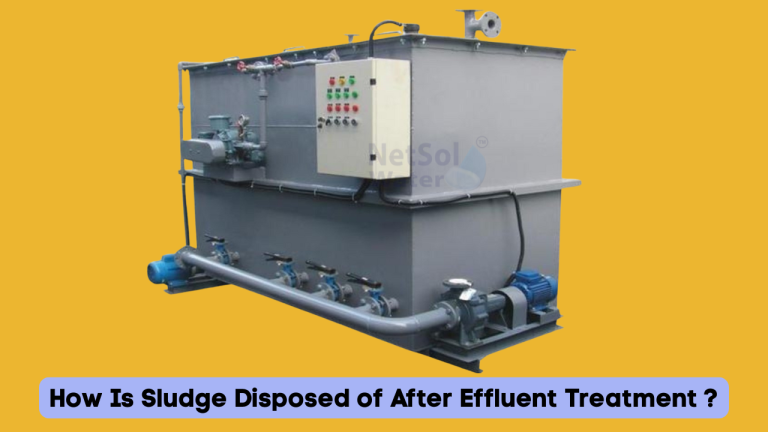
Effluent treatment plants play an important role in the industrial wastewater purification process before it is released into the environment. In this process, the toxic contaminants are removed but in doing so it leaves a byproduct that is referred to as sludge. Proper disposal of the sludge is as important as cleaning the water. The majority of individuals are interested in How Is Sludge Disposed of After Effluent Treatment or after it has drained from the water.
In this blog, we will be explaining how sludge disposed of after effluent treatment plant is treated, what procedures are used, and through what mechanism the disposal can be made in multiple different manners. It compiles industries to be eco-friendly and follow government regulations.
What Is Sludge?
Sludge refers to the heavy mud-like by-product remaining from processed industrial wastewater. Sludge has organic and inorganic makeup in the nature of chemicals, heavy metals, oil, and microbes. The leftover sludge, even though not safe to be allowed into nature, must be treated and get rid of.
Why Sludge Disposal Is Important
Sludge disposal in an unsuitable way may contaminate water and land. It is harmful to the ecosystem and human life. Industries are asked to perform certain actions that sludge disposed of after effluent treatment is done safely and correctly.
Major Steps in Sludge Disposal
Sludge disposal is a process with many steps. Each step minimizes the hazard, weight, and volume of sludge.
1) Sludge Collection
The sludge is mostly liquid state with a high water content after the effluent has been subjected to treatment and removed sludge or solid waste from clarifiers or settling tanks.
2) Filtration
The second is to reduce the level of water in the sludge. This can be done by thickening using gravity or mechanical thickening equipment. Thickening makes the sludge manageable and has the effect of lowering transportation and treatment costs.
3) Stabilization
In the process, sludge is processed to destroy odor and pathogenic bacteria or dangerous bacteria. It’s usually done through anaerobic or aerobic digestion. Stabilized sludge is less toxic and less likely to be a source of environmental pollution.
4) Dewatering
Dewatering removes even more water from sludge, making it solid or semi-solid. It is done by machinery like:
- Filter presses
- Centrifuges
- Belt presses
Dewatered sludge is less difficult to transport and dispose of.
Techniques Applied for Disposing of Sludge
There are numerous techniques applied to dispose of the treated sludge. The technique applied depends on the type of sludge, environmental control, and facilities.
1) Landfilling
Dispose in a controlled landfill is one of the most common practices. The sludge must be treated before dumping so that its destructive effects are lessened. Where it shall be dumped, it should be lined so that it will not pollute the soil.
2) Composting
If the sludge is highly organic, it may be mixed with other material and composted. It is turned into soil-compost commodity that can be sold to farmers for use as a fertilizer, although only after safety tests.
3) Incineration
It utilizes high temperature burning of the sludge in a special furnace. Incineration will decompose the sludge to a smaller volume and eliminate harmful chemicals. It is expensive and needs efficient air pollution control.
4) Land Application
In some cases, treated sludge is employed straight away on land, especially for crops not suitable for human consumption. It can make the soil richer but precautions need to be taken as per special rules so that it doesn’t pollute.
5) Construction Use
Sludge is excavated in other industries to be used for the manufacture of bricks or as filler in building materials. It is a good way of recycling waste but depends on the chemical composition of chemicals present in the sludge.
Sludge Disposal Problems
- Cost: Disposal and treatment are expensive.
- Space: Landfill space available is increasingly hard to come by.
- Risk of Pollution: Treated sludge that has not been properly treated can be a polluting agent.
- Government Regulations: Sludge disposal must comply with pollution control regulations, which may be local in nature.
Industries must regularly test the sludge quality and choose a method that is safe and legal.
Conclusion
Managing how sludge disposed of after effluent treatment is a key part of keeping our environment safe. From thickening and dewatering to landfilling or recycling, every process has to be performed with care. The process that has been followed should safeguard nature, lower health hazards, and follow all the defined norms.
Correct disposal of sludge is not just a necessity — it’s a duty to cleaner industry and a greener future.
Do you need an advice or assistance on selecting the best water and waste water treatment unit? We have solutions for all your problems!
Let us know your problem, our experts will make sure that it goes away.
For an assistance or related query,
Call on +91-9650608473
Or write us at enquiry@netsolwater.com
